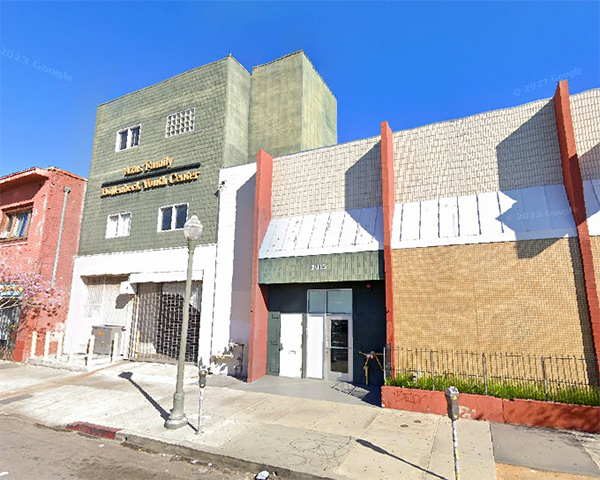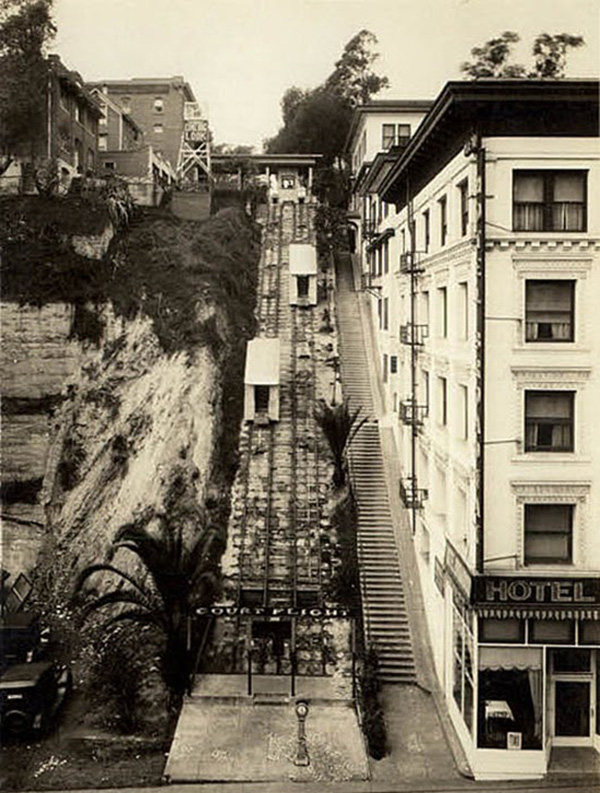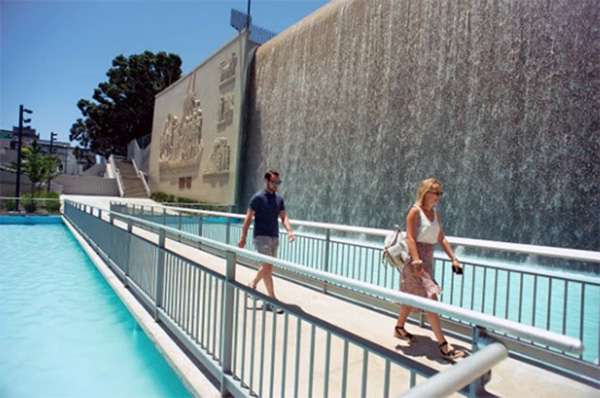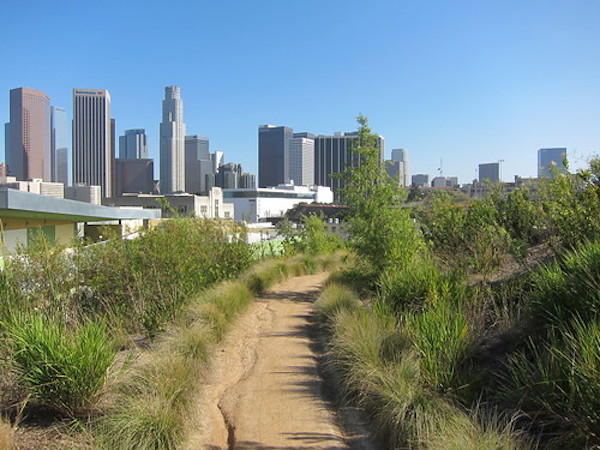This Sunday’s CicLAvia will be the 56th-ever event, the seventh one this year and the 17th version of the “Heart of L.A.” route, which has run between Central Los Angeles to the Eastside (the real Eastside, that is) via Downtown Los Angeles and a crossing over the Los Angeles River since CicLAvia began on the auspicious day of October 10, 2010 (10/10/10, remember?), which means this Sunday, we’re celebrating 14 years of open streets in Los Angeles. Though the HOLA course has had myriad variants over the years, this will be the fourth time the route travels between Echo Park to the Eastside (the first time being the October 5, 2014 CicLAvia that ran between Echo Park and Belvedere Park in East Los Angeles – a.k.a. Teh Hottest CicLAvia Ever at 97º). Fortunately, a decade later, we won’t have to worry about such sweltering conditions, as the forecast for this Sunday calls for an extremely perfect 76º on the thermometer.
The HOLA route will undoubtedly bring in a large crowd (as all CicLAvias do when they involve DTLA, Hollywood or the beach). This being October, CicLAvians represent in full force wearing either Halloween costumes or their Doyer gear as it’s the MLB Postseason. But for the latter, it’s truly a May Or May Not situation since as of this writing, The Boys in Blue are slated to play a crucial deciding Game 5 of the National League Division Series against The Little Brothers in Brown on Friday, October 11. And True Blue fans will be on the streets this Sunday wearing their Doyer gear in full force in the biggest NLCS Pregame Party evar. And this being a big election year – both nationally and locally, be on the lookout for candidates along the route pretending that they ride bikes all the time. Either way, win or lose, It’s gonna be Another Perfect Day on the CicLAvia route this Sunday!
As usual — Happy CicLAvia, Go Dodgers in the NLCS (be it in the 2024 NLCS or the 2025 Season), Go Rams, Go Kings Go and see you or not see you on the streets!
If you found this Epic CicLAvia Tour guide useful and visit any of these sites, please add the #EpicCicLAviaTour hashtag to any social media post that includes it. The Militant will be glad to re-tweet!
And if you appreciate The Militant’s work, kick him a little love via PayPal! He *hates* asking for money, but you know how it is these days…A Militant’s gotta pay his bills! He sacrifices a lot of his time to do this! Your support is much appreciated!
Support The Militant Angeleno!
https://www.paypal.com/donate/?hosted_button_id=K5XC5AM9G33K8
Thank you Rolando Reyes and Eddie Arias for your support over the past month!

1. Evergreen Cemetery
1877
204 N. Evergreen Ave, Boyle Heights
Over 300,000 Angelenos are laid to rest in this 67-acre cemetery — one of Los Angeles’ oldest. The interred are a microcosm of the city itself: people of all races are buried here, as are the rich and influential (including former Los Angeles mayors and people named Van Nuys, Lankershim and Hollenbeck) to the impoverished. The cemetery also includes recently-reinterred remains of 19th-century Chinese immigrants that were discovered while construction crews dug the Metro Gold Line tunnels nearby. The cemetery hasn’t lived up to its name lately, but taking a stroll through the grounds here can offer a unique history lesson.

2. Original Site of Canter’s Deli
1931-1973
2323 Cesar E. Chavez Ave (Brooklyn Ave), Boyle Heights
You may or may not be familiar with the local institution on Fairfax Avenue, which boasts “Since 1931.” That’s not entirely true. In 1931 brothers Ben, Max and Harry Canter opened their first delicatessen here on what was then Brooklyn Avenue near Soto Street. Following the post-war migration of Los Angeles’ Jewish community to the Westside, Ben Canter opened a new location on Fairfax Avenue, and in 1953 it moved down the street to the present location. The original Boyle Heights Canter’s closed in 1973.

3. Breed Street Shul
1923
247 N. Breed St., Boyle Heights
This Orthodox Jewish synagogue, formally known as Congregation Talmud Torah and originally established in 1915, was the heart of what was once the largest Jewish neighborhood in the Western U.S. The current structure was built 101 years ago to accommodate a growing congregation, In 1948, the Israeli flag was raised in Los Angeles for the first time here. Having been vacant and fallen to vandalism and disrepair since the 1980s, it is slowly undergoing a restoration process. It remains one of the most well-known landmarks of Boyle Heights’ Jewish community, which left the neighborhood after the late 1940s.

4. Hollenbeck Youth Center
1976
2015 E. First St., Boyle Heights
Established as a partnership between local businesses and the LAPD to provide activities and opportunities for local youth as a response to local riots and student protests in the early ‘70s, this youth center has benefited many kids from The Barrio, notably a local boy named Oscar de la Hoya, who first trained at the center’s boxing gym as a youth before winning an Olympic Gold Medal in 1992.
NAVIGATIONAL NOTE: If heading to DTLA, skip to #7.

5. Mariachi Plaza
1889
1st St and Boyle Ave, Boyle Heights
This is the new town square for Boyle Heights, where Mariachi musicians have been hanging out to get picked up for since the 1930s. The Kiosko, or bandstand, that sits in the plaza is actually not that historic. It was given as a gift from the Mexican state of Jalisco, who literally shipped it over in 1998 where it was assembled in place. But it only gets used once a year for the Santa Cecilia Festival around every November 21. The plaza is also home of the Metro E Line station of the same name, which opened in 2009 (as the Metro Gold Line). This place could warrant a Militant blog post in itself — no, an entire week of posts! Don’t miss the Farmers Market events there every Friday and Sunday!

6. Boyle Hotel/Cummings Block
1889
103 N. Boyle Ave, Boyle Heights
This brick Queen Anne-style building, built in 1889 and designed by architect W.R. Norton was one of the first commercial buildings in Boyle Heights, and is one of the longest-standing commercial buildings in all of Los Angeles. The hotel was an important social and political center in the late 19th and early 20th centuries, and in the 1960s, started to become a popular lodging spot for Mariachi musicians. It recently underwent a major renovation which created 51 low-income housing units and three street-level retail units, one of which is home of the Libros Schmibros bookstore/lending library.

7. Hollenbeck Park
1892
4th and St. Louis streets, Boyle Heights
John Edward Hollenbeck was a rich dude in the late 19th century who founded the First National Bank of Los Angeles and purchased parcels of land in Downtown, the San Gabriel Valley and the Eastside, where he made his home. Hollenbeck was also credited with the creation of what is now called Exposition Park. His sister married his friend, James George Bell, who founded…Yep, you guessed it! After Hollenbeck’s death in 1885, his widow, Elizabeth, donated a 21-acre parcel of land, which was essentially their front yard, to the City. One of the Los Angeles’ oldest parks, it was established in 1892 and continues to function today.

8. Boyle Henge
2015
Southwest corner of 6th Street and Boyle Avenue, Boyle Heights
On the Boyle Heights side of the 6th Street viaduct stands a curious, quirky, ever-changing assemblage of concrete blocks (resembling the referential Druid structure in the English countryside), and sometimes garden gnomes and animal statues. Whatup with this? Apparently it’s an art installation made by some locals who call themselves “Circle 6,” that were “inspired by the work of artists Christo and Jeanne-Claude.” Boyle Henge even has its own Instagram account.

9. 6th Street Viaduct (2.0)
2022
6th Street over the Los Angeles River, Downtown Los Angeles & Boyle Heights
The 6th Street Viaduct is really a tale of two bridges: The first, built in 1932, crossing over the Los Angeles River and several railroad tracks, lived a decent life serving as a 24-hour mediator between Downtown Los Angeles and Boyle Heights, occasionally doing extra work in movies, television shows and music videos. But in the mid-2010s, it was diagnosed with Alkali-Silica Reaction, a very lethal disease it had since birth, where high alkaline content in the concrete would cause it to become brittle and collapse in an earthquake. So it had a farewell celebration in October 2015 and it was euthanized in February 2016.
But, after a 6-year re-animation process in July 2022, the 6th Street Viaduct 2.0 was reincarnated into a slick, cybernetic form. It had large curving arches (that people could easily climb on), bright, programmable LED floodlights (that made it Instagram-friendly) and a wider road where people could do donuts and…things got out of hand. The bridge was closed for a time, because of the behavior of 21st century people and their reactions with 6th Street Viaduct 2.0.
But things have calmed down since and today you can ride, walk, jog, scoot or just chill on 6th Street Viaduct 2.0. – just as long as you do it during the daytime as the bridge is totally dark at night due to some punks stealing the copper electrical wiring this past Summer…) It has since become another visual icon of Los Angeles and one of the city’s most unique public spaces.

10. Site of Southern Pacific Arcade Station
1888-1914
4th and Alameda streets, Downtown Los Angeles
Before there was a Union Station, there were various rail passenger terminals in Los Angeles, many of them just a short distance from the Los Angeles River. On what currently stands as a large shopping mall, this was the original site of the Southern Pacific Railroad’s Arcade Station which served passengers up until 100 years ago. A popular landmark of this station was a young palm tree, which was moved a century ago to Exposition Park where it stands today, much taller, in front of the Los Angeles Memorial Coliseum. Unfortunately for indie rock fans, the Arcade Station was not devastated by a Fire, but was dismantled and replaced by a new station, the Central Station, located one block south.

11. Shohei Ohtani Mural
2024
328 E. 1st St., Little Tokyo
This 150-foot tall mural of Dodgers mega-star and 50/50 Club founder Shohei Ohtani on the east-facing wall of the Miyako Hotel Los Angeles was painted over 13 days in March 2024 by artist and Boyle Heights native Robert Vargas. Formally entitled, L.A. Rising, the $700 Million Dollar Man is depicted twice, reflecting his two-way nature: the large image shows him post-swing as a designated hitter and the smaller likeness depicts him pitching on the mound (which we won’t get to see until 2025). The artist painted the mural – the largest of several bearing The Unicorn’s likeness – freehand, sans projections using suspended scaffolding. Look for signage for the mural along 1st street which contains a QR code to view an Augmented Reality animation of the mural with your smartphone!

12. Fugetsu-Do
1903
315 E. 1st St., Little Tokyo
Owned by the Kito family for three generations, this confectionery shop, which specializes in mochi and manju rice cakes and other sweet treats from the Land of the Rising Sun, is not only Little Tokyo’s oldest-operating business, but the oldest Japanese American-owned business in the United States. Founded in 1903 by Seiichi Kito, an immigrant from Gifu, Japan it is currently owned by his grandson, Brian and still operated by members of the Kito family. Though the shop has been located on east 1st Street since 1903, it has operated over the years in three storefronts: the first until 1942 (when the family was incarcerated with other Japanese Americans at Heart Mountain, Wyoming during World War II), a second location in 1946, and the current location, which opened in 1957. The name “Fugetsu-Do” is the generic term for “confection shop” in Japanese.

13. Los Angeles Sister Cities Monument
1987
1st and Main streets, Downtown
On the northeast corner of 1st and Main streets stands a pole bearing signs (in the “Blue Blade” style, no less) for every one of Los Angeles’ 25 Sister Cities, each pointing towards their location. The signs range from Lusaka, Zambia (the farthest sister city, 10,017 miles) to Vancouver, Canada (the nearest, 1,081 miles) and everywhere in between. Nagoya, Japan is Los Angeles’ oldest sister city (1959); Yerevan, Armenia is the newest (2007). Los Angeles, an Olympic host city (1932, 1984, 2028) also has that in common with sister cities Athens (1896, 2004), Berlin (1936), Mexico City (1968) and Vancouver (2010).

14. Site of 1910 Los Angeles Times Bombing
1910
Northeast corner of Broadway and 1st Street, Downtown
This longtime empty lot, previously the foundation of a state office building condemned after the 1971 Sylmar Earthquake, has some additional history. It was recently dissevered to be the location of the 1910 bombing of the (then) Los Angeles Times building, which happened 113 years ago this month. The dynamite bombing was discovered to have been the work of Ortie McManigal and brothers John and James McNamara, all affiliated with the Iron Workers Union, in what was meant to protest the newspaper’s staunchly anti-union practices at the time. Twenty-one people died when the 16 sticks of dynamite exploded just outside the building at 1:07 a.m. on October 1, 1910. The explosion was exacerbated by natural gas lines which blew up a large section of the building. The Times since built a new building in its place, and later relocated across 1st Street before it moved out to El Segundo in 2018. The site may or may not be a public park in the future.
NAVIGATIONAL NOTE: If heading west to Echo Park, skip to #21.

15. Site of Court Flight
1904 (demolished 1943)
Broadway between Temple and Hill streets, Downtown
You all know Angels Flight, but it’s time to pay tribute to the city’s other funicular, its cousin to the northeast, Court Flight. Built in 1904, it went up the northern end of Bunker Hill and was next to a former road called Court Street, hence its name. Even shorter than its more famous cousin at 200 feet, it ran steeper at a height of 200 feet. It was burned by a fire in 1943 and never reconstructed. The hill was eventually chipped away to create the Civic Center. The north side of the stairways going up to the Court of Flags (wonder if that was intentional there) in today’s Grand Park is the precise location of ol’ Courty.

16. Hall Of Justice
1926
Temple Street and Broadway, Downtown
No, you won’t find Superman or any of the Super Friends here. But this building, the oldest surviving government building in the Los Angeles Civic Center, was built in the mid-1920s as the original Los Angeles County Courthouse and Central Jail (which once housed the likes of Busy Siegel, Sirhan Sirhan and Charles Manson), as well as the headquarters for the Sheriff’s Office, the District Attorney and the County Coroner. This Beaux Arts-style building was designed by Allied Architects Association, an all-star team of local architects put together to design publicly-funded buildings. In the 2010s, the building underwent a major renovation project to modernize the facilities and repair damage from the 1994 Northridge Earthquake. It is now a LEED Gold Certified building (gotta be sustainable, y’all), following the 2015 restoration.

17. Fort Moore Pioneer Memorial
1957
451 N. Hill St, Downtown
Way, way, waaaaay back before we had tall building and freeways, Downtown Los Angeles (well Los Angeles, period back then) had a bunch of hills, Bunker Hill being the most famed one. There was also Fort Hill, the site of a Mexican-American War encampment. On July 4, 1847 the facility was called Fort Moore (and the hill Fort Moore Hill), after Captain Benjamin D. Moore of the U.S. 1st Dragoons regiment, who was killed six months earlier in a battle near San Diego. The 1st Dragoons and the Mormon Batallion established the new fort and raised the U.S. flag during the first-ever observed Independence Day in Los Angeles. This event was immortalized in a bas-relief stone monument made in the 1950s. Speaking of forts, the very street you’re riding (or walking, or skating, or scootering, or stand-up-paddling, or pogo-sticking) was once called “Fort Street,” which inevitably led to directional problems some six blocks south of here. The monument also includes a fountain, which was shut off in 1977…due to the drought at the time, but revived in 2018 after a massive renovation. So where’s the actual hill, you ask? It was bulldozed away in the late 1940s to make room for the 101 Freeway.

18. Chinatown Gateway Monument
2001
Broadway and Cesar E. Chavez. Avenue, Chinatown
Designed to be the symbolic entrance to Los Angeles’ Chinatown District, The Chinatown Gateway Monument, a.k.a. the Twin Dragon Towers Gateway, depicts two dragons grabbing at a central pearl, which symbolizes luck, prosperity, and longevity. The 25-foot-tall structure was put up in 2001 and occasionally emanates steam coming from the dragons’ mouths. Unlike Anglo dragons, the creatures in Chinese folklore are the good guys, meant to scare away evil spirits.

19. Capitol Milling Company
1883
1231 N. Spring St, Chinatown
One of the last visible vestiges of Los Angeles’ agricultural industry, this family-owned flour mill operated from 1831 to 1997, before moving its operation to a much larger facility in Colton. The facility that still stands today was built in 1883. The mill supplied flour to clients such as Ralphs, Foix French Bakery and La Brea Bakery. In 1999, the family-owned operation was purchased by industry giant Con-Agra Co. The historic building – the oldest commercial building in Los Angeles, built even before the railroads arrived in Los Angeles, still has a horse-tethering ring, back to the days when grain was hauled by horse carriage from farms in the San Fernando Valley. The eight-building complex, now owned by the Rivoli family (who owns the San Antonio Winery across the river), underwent a massive renovation completed in 2020 so that the 19th century facility can live on in the 21st century as office, retail and restaurant spaces.

20. Chinatown Central Plaza
1937
Gin Ling Way between Broadway and Hill, Chintown
The northern terminus of CicLAvia is no stranger to public events; it was made for them. During the Summertime it hosts KCRW’s popular Chinatown Summer Nights parties. But don’t let the “Old Chinatown” neon sign fool you — This is actually Los Angeles’ new(er) Chinatown, which dates back to the 1930s. The real Old Chinatown was several blocks south, where a thriving community of Cantonese-speaking immigrants lived near the river, north of Aliso Street. Of course, they were kicked out in the early ’30s to make room for Union Station. So they moved a few blocks north, in the former Little Italy, and they’ve been there ever since. Well, not really, since some of them moved east to the San Gabriel Valley and were supplemented with Mandarin-speaking immigrants from Taiwan and Mainland China. But you get the idea.

21. U.S. Federal Courthouse
2016
145 S. Broadway, Downtown
This big glass cube that is responsible for blocking your view of the Downtown Los Angeles skyline from Grand Park used to be a hole in the ground was once the site of the Junipero Serra State Office Building, which was damaged in the 1994 Northridge Earthquake and abandoned and demolished in 1998. This 10-story, 400-foot-tall U.S. Federal Courthouse building (don’t we already have a few of those?), designed by Skidmore Owings and Merrill, opened in 2016. Do check out the super subtle embossed-glass bald eagle situated over the main entrance on 1st Street.

22. Pacific Electric Tunnel
1925
Toluca Street south of 2nd Street, Downtown
For 30 years, Los Angeles’ first subway tunnel allowed the Pacific Electric’s Red Cars to bypass the traffic of Downtown’s surface streets and sped up the travel times to places like Burbank, Santa Monica or the San Fernando Valley before it was abandoned in 1955. Soon after, the area surrounding the tunnel portal and adjacent electric power substation became blighted and a haven for the homeless and graffiti artists, while the tunnel itself became part garbage dump, part urban spelunking adventure (The Militant has been in the tunnel before). In 2007, a large apartment building designed for upscale, gentrifying types was built on the site of the Red Car yard, thus blocking the tunnel and dashing any hopes of it being revived as part of our modern rail system (it’s been holding up well structurally for nearly 60 years without any maintenance whatsoever). But if you look at the back of the property, you can see the boarded-up tunnel with an artistic homage to its former purpose (and do browse the apartment building’s lobby for some PE photos and diagrams).

23. Vista Hermosa Natural Park
2008
100 N. Toluca Street, Echo Park
The Militant loves to poke fun at the failures of the Los Angeles Unified School District, but once in a while, those failures turn out to be wonderful things. Take for instance the Belmont Learning Center, at one time the LAUSD’s costliest boondoggle, which was stalled and scaled back due to environmental concerns (there used to be oil wells around here). The school district gave up a portion of its land to the Santa Monica Mountains Conservancy, who in turn built a really beautiful oasis of California native plants and a killer view of the DTLA skyline. The Militant covered its opening back in 2008. It’s more than worth visiting during CicLAvia, or at any other time.

24. Historic Filipinotown Gateway
2022
Beverly Boulevard between Belmont Avenue and Glendale Boulevard
October is recognized as “Filipino American History Month,” so appropriately, the Filipino community, comprising of roughly half a million in the Los Angeles metropolitan area, is the largest Asian group in the City of Los Angeles. People of Philippine ancestry have been living in Los Angeles since the early 1900s, originally concentrated in an area once called “Little Manila,” where Little Tokyo is today. The community migrated westward along the Temple corridor as it grew, and later spread into other communities like Eagle Rock, East Hollywood and parts of the San Fernando Valley (particularly Panorama City), especially after larger waves of immigration came starting in the mid-1960s. The Historic Filipinotown neighborhood still contains major institutions in the community such as businesses, nonprofit organizations and churches, which prompted its formal designation by the City in 2002. Twenty years later, a large $750,000 gateway arch over Beverly Boulevard, designed by artist Eliso Silva with Philippine cultural elements was dedicated in May 2022, and it looks even nicer when lit up at night.

25. Echo Park Recreation Center
c. Early 1900s
Glendale Boulevard at Temple Street
You might pass this tennis court and nearby swimming pool every day and wonder, “Who the hell would put a tennis court/swimming pool right next to a freeway?” Well, no one put them next to a freeway, but they put the freeway next to them. Before 1948, Echo Park wasn’t just a pretty little lake with lotus flowers and paddle boats, but it was a park park, with recreation facilities and everything. It stretched as south as Temple Street. But it stood in the path of the almighty Cahuenga Parkway (now the Hollywood Freeway, or “The 101”), which cut the park in two. Hmm. That sounds familiar…Pictured is the park (with Temple Street in the foreground – notice the trolley and horses and buggies(!) in 1909.

You must be logged in to post a comment.